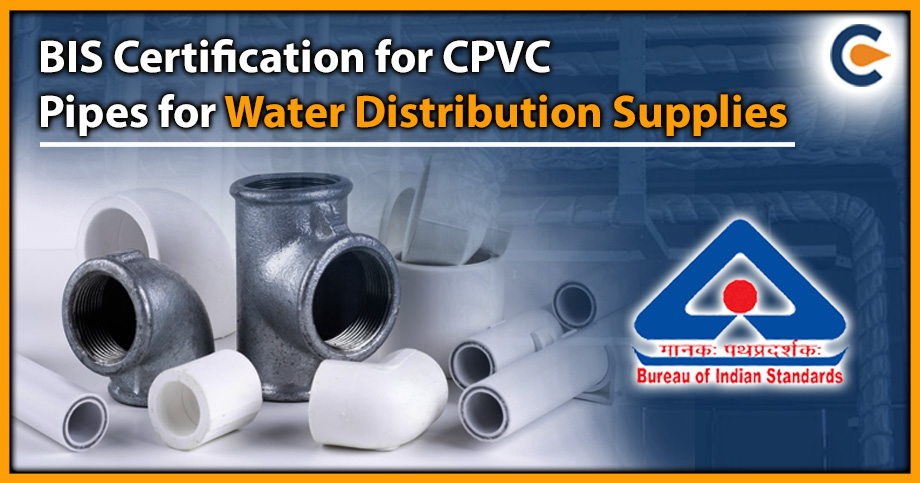Chlorinated polyvinyl chloride, broadly known as CPVC, refers to a thermoplastic that is manufactured by subjecting PVC resin to a chlorination process. When compared with PVC, CPVC possess better flexibility and higher resistance to rising temperature. CVPC pipes are widely used in the commercial, agriculture, and industrial sphere and are deemed safe to carry portable water. Pipe makers must comply with IS 15778:2007 before introducing CPVC pipes into the market. The said standard entails manufacturing, quality, and labelling norms. The standard also mandates manufacturers to affix a mandatory ISI marking on their finished pipes. Let’s understand the requirements around the BIS Certification for CPVC Pipes for Water Distribution Supplies.
Understanding Requirements Under the IS 15778:2007
IS 15778:2007 specifies requirements around the Chlorinated polyvinyl chloride (CPCV) pipes that are specifically used to carry cold and hot water within a temperature range of 27°C-82°C.
Pipe Categorization
The standard has categorized these pipes based on the pressure rating that varies as the fluid’s temperature increases.
|
Pressure class |
Working pressure in MPa |
||
|
SDR |
27degree C |
82 degree C |
|
|
Class 1 |
11 |
2.76 |
0.68 |
|
Class 2 |
13.5 |
2.18 |
0.55 |
|
Class 3 |
17 |
1.73 |
0.42 |
Material and Quality Requirements
- The base material used for the production of the CPVC pipes should be chlorinated polyvinyl chloride.
- Some additives may be added to pipes while production to improve their appearance and mechanical strength. But the threshold of their quantity should not cause environmental or other damages of any kind.
- The finished pipes should be able to sustain the operating temperature range as mentioned under the standard.
- The finished pipes should be free from any structural flaws that can lead to pipe failure.
Testing Requirements for CPCV Pipes under IS 15778:2007 – BIS Certification for CPVC
The CPVC pipes must pass the following tests to qualify for the BIS ISI marking scheme:
- Type test
- Acceptance test
- Opacity test
- Reversion test
- Vicat Softening Temperature
- Hydrostatic pressure test
- Resistance to External Blow
- Flattening test
What Are The Marking Norms For CPVC Pipes As Per IS 15778:2007?
Every pipe maker should label their pipes with the following information without fail:
- Manufacturer’s name or trademark,
- Outside diameter,
- ISI marking
- Pipe and pressure rating class,
- And batch number as per specification
Documents for BIS Certification for CPVC Pipes for Water Distribution Supplies
Following is the list of documents required for BIS Certification for CPVC Pipes for Water Distribution Supplies:
- Business-related paperwork such as certificate of incorporation and partnership deed.
- Industry-specific permits such as SSI certificate and factory license
- Applicant’s firm details
- Trademark registration
- Flowchart concerning the production process
- List of products manufactured at the facility
- List of machinery available at the production facility
- Testing report of the products granted by the certified lab
- List of in-house lab testing equipment along with their calibration report.
- Detail concerning the QMS
- Authorization letter permitting the agent to handle licensing formalities.
Process Concerning the BIS Certification for CPVC Pipes for Water Distribution Supplies
Section below talks about the procedure concerning the BIS Certification for CPVC Pipes for Water Distribution Supplies
Step 1: File web-based application for ISI Marking
The process of the BIS ISI scheme registration commences with the online application filing. The e-application for BIS ISI certification is available on the BIS portal.
While filing an application, make sure to enclose all the mandatory details and upload the aforesaid documents. The fee submission is the last step in online application filing.
Step 2: Paperwork vetting and sample collection
The application submission is followed by the paperwork inspection, which will stay in effect till the authority gets assured of document authenticity.
Upon document vetting, the BIS official[1] will pay a visit to the production facility to perform a quality assessment of the internal processes.
This would also involve the random selection of some product samples, which will undergo lab testing
Step 3: Sample Testing and Report Generation
The selected samples will then be sent to the BIS-recognized lab, which will perform a couple of prescribed tests as mentioned below for quality assurance;
- Type test
- Acceptance test
- Opacity test
- Reversion test
- Vicat Softening Temperature
- Hydrostatic pressure test
- Resistance to External Blow
- Flattening test
The findings of all these tests will find their way to an extensive report, which will also serve as proof for quality assurance.
Step 4: Report Collection
The intimation regarding the report generation shall be shared with the applicant via registered contact details. The applicant must collect the report on time and submit it to the BIS for verification.
It is vital to note down that such a lab report stays valid for a limited timeframe. Therefore, its timely submission is vitally important.
Step 5: Test report review and grant of certificate
The authority will review the test report for any possible non-conformity and accordingly accord the BIS ISI certification.
Conclusion
BIS Certification for CPVC Pipes for Water Distribution Supplies is mandatory for the pipe makers. Products that lack mandatory ISI marking or required quality standards shall stand ineligible to be sold in the market.
Read Our Article: BIS ISI Certification For Ordinary Portland Cement













